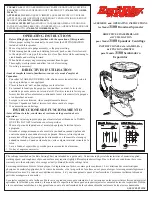
Overview
Installation Guide
2
CSI Readers
Note:
When connecting a reader to a DPU-7920 series controller, a breakout box is only necessary
when the installation requires the use of an RJ45 connection. Otherwise, readers connect to
the DPU-7920 series controllers through two eight-position plug-on terminal blocks (TB3
and TB4). Refer to TCON117, Model 7920 Door Processing Unit Installation Guide, for
more information.
Table 2. Reader Signal Breakouts
Terminal
Number
Signal
Function
1
+DC Power
13 VDC power supplied to the reader from the DPU. Maximum current drain for each
reader should be 50 milliampere. This conductor typically powers CSI and ABA
Mag-Stripe readers.
2
Chassis
(DPU-7910A)
Connect the shield from the reader cable here. If the ground is to originate from the DPU,
the plug-on shunt/jumper labeled J12 should be placed across posts A and B. This jumper
is shipped from the factory plugged on to the B post only (i.e., no chassis ground
connection on terminal 2).
CAUTION!
Ground reader cable shield at only one point.
AUX
(DPU-7920)
When combining an I/DISC reader with an ESSEX PIN pad (supported in I/NET versions
4.3x and later), this conductor carries the DATA signal from the I/DISC reader. Otherwise,
this pin is not used.
CAUTION!
Do
not
connect the Chassis GND signal from a key/card reader to this
terminal on the DPU-7920. Instead, connect the Chassis GND signal from the reader to
a good earth ground.
3
DATA
With Mag-Stripe and I/DISC readers this conductor carries the DATA signal from the
reader.
DATA-1
With Wiegand readers this conductor carries the DATA-1 signal from the reader. The
signal, which normally rests at 5 volts, will pulse to 0 volts (minimum 50 milliseconds pulse
duration) upon the detection of logic 1 bits in the Wiegand data sequence.
4
+DC Power
5 VDC power supplied to the reader from the DPU. Maximum current drain for each reader
should be 50 milliamperes. This conductor typically powers Wiegand readers.
5
CLOCK
With the Mag-Stripe readers this conductor carries the CLOCK signal from the reader.
This signal will normally rest at 5 volts and pulse to 0 volts while the data on conductor
number 3 is valid. This signal is called STROBE by some ABA reader manufacturers and
CLOCK by others.
DATA-0
With Wiegand readers this conductor carries the DATA-0 signal from the reader. The
signal, which normally rests at 5 volts, will pulse to 0 volts (minimum 50 milliseconds pulse
duration) upon the detection of logic 0 bits in the Wiegand data sequence.
6
Red LED
This signal drives a red LED located in the reader. The actual color of the LED to which it
connects is not critical except to note that future references to red LED function/operation
in this document refer to the LED connected to this conductor.
When a Wiegand reader type is selected, this signal will drive to 0 volts to turn the LED
ON.
When setting the reader type to CSI, ABA, Indala proximity, Watermark, or I/DISC, this
signal will drive to 5 volts to turn the LED ON.
The DPU momentarily illuminates the red LED to show when a key/card or touch tag was
successfully read but not authorized to release the door. The red LED will flash for a
couple of seconds when the DPU detects a key/card or touch tag entry, but does not
successfully read the data from the reader (i.e., a retry is necessary).
Содержание CARDPIN1
Страница 5: ...Installation Guide CSI Readers v Specifications 45 Index 49...
Страница 58: ......
Страница 59: ......









































